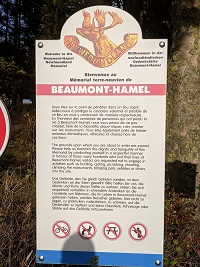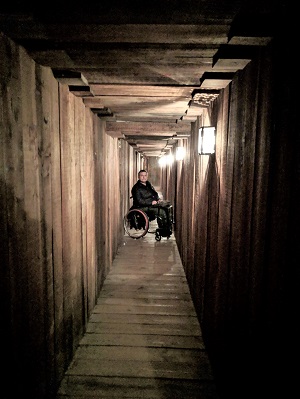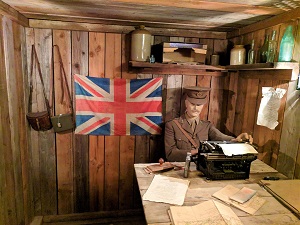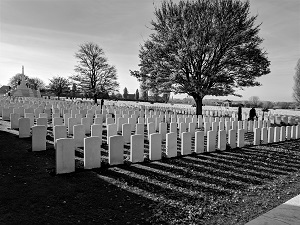Press Releases
←Back
Battlefield Tour - War Memorials of the Somme Region (France) and Ypres (Belgium)
On 13th and 14th November 2018, Christopher Auker-Howlett accompanied Uniformed Public Services students and teachers from Gloucestershire College on a trip to France and Belgium to visit various Memorial Parks and Museums. It was very moving to see the pristine conditions in which these memorial sites have been kept and the museums bring the stark and brutal conditions of WW1 to life using a mixture of photography, video and exhibits.
Beaumont-Hamel Newfoundland Memorial Park
Travelling to the Somme area in northern France we arrived at the Newfoundland Memorial Park. This stands as an important symbol of remembrance and a lasting tribute to all Newfoundlanders who served during the First World War. At the heart of the memorial stands a great bronze caribou (the emblem of the Royal Newfoundland Regiment). Its defiant gaze forever fixed towards its former foe, the caribou stands watch over rolling fields that still lay claim to many men with no known final resting place. Read more...

Entrance sign to Memorial Park

The caribou monument that gazes forever vigilant over the battlefield

Artisitic photo merging old WW1 photo with a modern day picture of the tranches, covered in poppies

Image of Christopher Auker-Howlett taking in the sombre scene of Allied War Graves
Thiepval Memorial & Visitor Centre
Still in the Somme region, this memorial commemorates more than 72,000 men of British and South African forces who died in the Somme sector before 20 March 1918 and have no known grave, the majority of whom died during the Somme offensive of 1916.
On the high ground overlooking the Somme River in France, where some of the heaviest fighting of the First World War took place, stands the Thiepval Memorial. Towering over 45 metres in height, it dominates the landscape for miles around. It is the largest Commonwealth memorial to the missing in the world. Read more...

Thiepval Visitor Center

Photo wall showing some of the 'missing' of the Somme battle

Photo of Soldiers in the trench listening to orders

Thiepval Memorial - the largest Commonwealth memorial to the missing in the world

Small cemetery containing equal numbers of Commonwealth and French graves lies at the foot of the memorial

Photo of the inside of the memorial where thousands of soliders' names are inscribed

Poppy wreathes and crosses inside Thiepval Memorial to commemorate the fallen

Diagram showing the command structre of the British Fourth Army
Lochnagar Crater, La Boisselle
The Lochnagar mine crater on the 1916 Somme battlefields in France is the largest man-made mine crater created in the First World War on the Western Front. It was laid by the British Army's 179th Tunnelling Company Royal Engineers underneath a German strongpoint called “Schwaben Höhe”. The mine was exploded two minutes before 07.30 am Zero Hour at the launch of the British offensive against the German lines on the morning of 1st July 1916.
The British division attacking in this sector was 34th Division of III Corps. All twelve battalions in this division, each with a fighting strength of about 700 men, went into the attack that morning. Despite the successful blowing of the mine and the damage caused to the German strongpoint, the German defenders managed to get into well-placed positions to fire at the advancing British soldiers. Within half an hour of the start of the infantry attack many hundreds of them were already dead or wounded. Read more...

Photo taken from the lip of the crater looking across to the other side. It seems much bigger when you are peering into it!

Aerial photograph taken in 1980 over the Lochnagar Crater. The village of La Boisselle can be seen to the north of the crater. © greatwar.co.uk

Gloucestershire College Students with Lead Teacher, Richard Coughlin and Lead Networker, Christopher Auker-Howlett at the Lochnagar Memorial

Gloucestershire College Student dressed in WW1 Uniform, laying a cross at the Lochnagar Memorial

Two Gloucestershire College Students dressed in WW1 Uniforms

Poppy wreaths laid at the Lochnagar Memorial
Last Post Ceremony, Ypres
Did you know that in Ypres, Belgium, the Last Post Ceremony takes place every night at 20.00hrs and has been since the end of WW2?
The Ceremony consists of:
- Call to Attention by the buglers of the Last Post Association.
- Sounding of the “Last Post” bugle call.
- Minute of silence.
- Sounding of the “Réveille” bugle call.
The Last Post Ceremony has become part of the daily life in Ieper (Ypres) and the local people are proud of this simple but moving tribute to the courage and self-sacrifice of those who fell in defence of their town. Read more...

Photo of the Menin Gate in Ieper - Ypres

Crowds gather to witness the Last Post, played each evening at 8pm under the Menin Gate in Ieper - Ypres

Photo of poppy wreaths under the Menin Gate in Ieper - Ypres

Photo of the buglers playing the Last Post at the Menin Gate
Passchendaele, Zonnebeke
Officially known as the Third Battle of Ypres, Passchendaele became infamous not only for the scale of casualties, but also for the mud. It cost the Allied some 325,000 and German 250,000 casualties and with the heaviest rain in over 30 years falling in just a few days, many men and horses drowned in the muddy quagmire that was created. The combination of over half a million casualties and a territorial gain of a mere 5 miles have become a symbol of the great futility and violence of war in all its terror. Read more...
We visited a great museum called Memorial Museum, Passchendaele where they have the most amazing reconstruction of the British and German trenches and it is perfectly accessible to all levels for wheelchair users.

Photo of Passchendaele Memorial Museum

Various weaponry that would have been used on the battlefield

The colourful yet deadly shells used on the battlefield

The harrowing art installation showing arms rising out of the mud to depict those soliders who died by drowning in the sodden mud on the battlefield

Some trenches were deep beneath the battlefield. Here is Christoper Auker-Howlett inside a replica underground trench

The wounded needed to be tended to and a Padre was at hand to comfort soldiers in their final moments

Skilled engineers would have had their own workshop in the underground trench

An Officer typing up war reports
Tyne Cot, Zonnebeke
Tyne Cot Cemetery, which came into being in October 1917, is the resting place of 11,954 soldiers of the Commonwealth Forces. This is the largest number of burials contained in any Commonwealth cemetery of either the First or Second World War. It is the largest Commonwealth military cemetery in the world.
The dates of death of the soldiers buried at Tyne Cot cemetery cover a period of four years, from October 1914 to September 1918 inclusive Read more...
Langemark Cemetery
The last stop on our Battlefield Tour was to a German cemetery.
Langemark cemetery is one of only four First World War German cemeteries in the Flanders region. In the whole of Belgium there are 13 First and Second World War German military cemeteries.
During the 20th century, the bodies of many German soldiers were exhumed and brought to Langemark (one of three German collecting cemetaries) where there now lies over 44 thousand German bodies in mass graves.
The German cemeteries have a completely different feel to them than those of the Allies. Germany didn't have a lot of money after the First World War and so it took many decades to end up with the cemeteries that exist today. Read more...










































